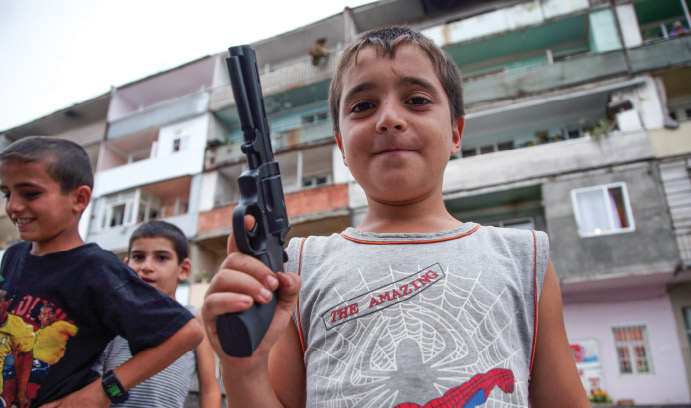War and Democratic Transition in a Post-Soviet Nation

Political science scholars continue to explore a fundamental question: why have some post-communist societies succeeded in their transitions to democracies while others have failed?
The topic is of particular interest to Arman Grigoryan, assistant professor of international relations, both academically and as a native of Armenia, a post-Soviet nation that commemorated a quarter century of independence in 2017.
The Republic of Armenia, bordered by Turkey to the west, Iran to the south, Georgia to the north and Azerbaijan to the east, is a nation of 3 million people. Armenia was one of the 15 constituent republics of the Soviet Union, becoming independent following the referendum of September 21, 1991.
In the years immediately preceding independence, a conflict had erupted between Armenia and its neighbor, Azerbaijan, over a region known as Nagorno-Karabagh, which was recognized as part of Azerbaijan, but was inhabited by Armenians. By 1992, the conflict had escalated into a full-blown war. By the time a Russian-negotiated ceasefire took hold in 1994, 30,000 lives had been lost and 1 million people had been displaced, according to the Associated Press. Tensions between the two countries remain high with closed borders between Armenia and Azerbaijan and Armenia and Turkey (Azerbaijan’s ally). Deadly skirmishes continue to break out such as one last spring that left at least 100 dead over a four-day period.
“In the first half of the nineties, Armenia was often referred to in the Western media as an ‘island of democracy,’” says Grigoryan. “It had a government that had been elected in free and fair elections and had embarked on a fertile period of legislative reforms.”
However, its early promise failed to materialize.
“Two decades later Armenia is anything but a democracy,” writes Grigoryan in a forthcoming paper. “Elections are routinely falsified; its human rights record is poor; and its level of corruption is appalling. At best, the country’s political system can be characterized as a hybrid regime and even that is a euphemism.”
Why Armenia Has Failed
According to Grigoryan, the main culprit behind Armenia’s failed transition to democracy was the war with Azerbaijan and the continued state of belligerence after the ceasefire was signed in 1994.

Grigoryan gave a presentation on the topic last year in Los Angeles as part of a panel during a conference titled “End of Transition: Armenia 25 Years On, Now What?” The conference, hosted by the University of Southern California’s Dornsife Institute of Armenian Studies, brought together notable names in media, government, academia and the arts to explore regionalisms of Armenia, demographic changes, transitions in social and economic policy, the development of formal and informal political and social institutions, bottom-up social change and civil society formation.
Grigoryan is exploring the broader topic of war and democratic transition for an upcoming book.
“There is no consensus in the literature on how war and democratic change are related,” he says.
During his talk, Grigoryan referred to a popular international relations theory known as the democratic peace theory. The theory maintains that there is something special about democracies and their foreign policy—particularly the way they relate to other democracies. It posits that liberal democracies have carved out a zone of peace that can be credited to liberal governments and a commitment to liberal politics.
Grigoryan argues against this idea.
“The evidence actually suggests a reverse causal arrow where peace causes democracy rather than democracy causing peace,” he says. Countries that have been able to settle their differences one way or the other, he adds, have had an easier time becoming and remaining democratic.
By contrast, he says that if you look at places where there continue to be raging conflicts or enduring rivalries—even if not active wars—there is “a serious democratic deficit there.”
War Is Bad for Democracy
According to Grigoryan, one of the reasons scholars have identified to explain why wars are bad for democracy is that wars—or, more generally, bad security environments—change the distribution of power between the state and society in favor of the state.
“Such environments empower the state and weaken society,” Grigoryan said during his talk. “This is natural because a state that is in a bad security environment—or is fighting a war—has to have an increased and uncontrolled executive authority. It has to have the ability to extract resources from its society. It has to have the ability to deter resistance against that extraction. It has to have the ability to make all sorts of difficult and unpopular decisions. It has to have the ability to make quick decisions without worrying about checks and balances. And, it has to have the ability to control information.”

None of these things, he points out, are good for democracy.
Armenia, one of the most militarized states in the world according to the Global Militarization Index 2016, is vulnerable to what Grigoryan calls a “psychological predisposition toward totalitarianism common in war societies where dissent becomes equivalent to treason.”
He cites the overheated rhetoric against the peace platform of one of the opposition parties in Armenia during the recent parliamentary elections campaign as an example of that.
When it comes to this particular post-Soviet state’s long-term outlook, Grigoryan believes that democratizing Armenia depends on recognizing the detrimental effects that the war or the state of belligerence with Azerbaijan plays, concluding: “Unless a genuine effort is made to resolve our conflicts with our neighbors, we can scarcely hope that Armenia will ever become a democracy.”
This story appears as "War & Democracy" in the 2018 Lehigh Research Review.
Posted on:




